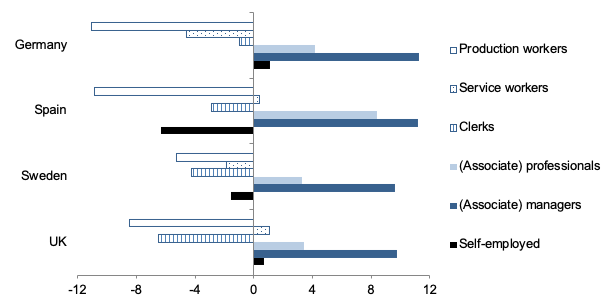Over the last few years, it has become widely accepted among economists that the Northern American and European job structure is polarising (Autor and Dorn 2013, Goos et al. 2014). Polarisation is defined as employment growing both in high-skilled and low-skilled occupations but decreasing in mid-paid occupations. The result is the hollowing out of the employment structure and, allegedly, the erosion of the middle class (OECD 2017).
Job polarisation would be remarkable because it contrasts with the European experience of the past 40 years, where technology has constantly increased the demand for high-skilled workers at the expense of low-skilled workers, where the onset of globalisation shifted labour-intensive mass production from the North to the South, and where educational expansion massively augmented mid- and highly qualified labour supply. Polarisation thus seems paradoxical, as it runs counter to main forces that shaped the job structure over the recent past.
Measuring occupational change
In a new paper, we resolve this paradox by showing that the empirical case for polarisation is weak for Western Europe (Oesch and Piccitto 2019). We use the European labour force survey and examine the pattern of occupational change between 1992 and 2015 for Germany, Spain, Sweden, and the UK.
We rank-order the occupations at the beginning of the 1992–2015 period based on their median work income (from the European Structure of Earnings Survey) and on their mean education. These rank-ordered occupations are then grouped into five equally large job-quality quintiles. Quintile 1 comprises the highest-paid/most-educated occupations and quintile 5 the least-paid/lowest-educated occupations.
Contrary to earlier studies (Goos et al. 2014, OECD 2017), our study uses detailed measures of occupations (with ISCO 3-digit), determines work incomes and educational levels of occupations for each country separately, and includes the entire workforce in the analysis, notably agricultural workers, part-timers, migrants, the self-employed, and civil servants. Including the entire workforce is crucial because the employment shares of these categories were anything but stable over time. For instance, by omitting agriculture, we underestimate the job decline in low-end occupations in all those countries that still had sizeable farm sectors in the 1990s.
Employment expanded in the top quintile
Our results are shown in Figure 1, where occupations are rank-ordered into job-quality quintiles based on work income. It shows that job growth was strongest, in all four countries, in the top-quintile occupations, where median earnings are highest. The proportion of employment in these top-end occupations increased by 9 to 12 percentage points – from 20% at the beginning of the 1990s to about 30% in 2015. In parallel, the employment share of the bottom quintiles declined everywhere by 3 to 5 percentage points, except in the UK where it increased and led to polarisation.
Figure 1 Change in the employment structure, 1992–2015 (percentage points)
Note: Occupations allocated into quintiles based on their median work income.
Data source: European Labour Force Survey; period for Sweden: 1997–2015.
In Figure 2, we replicate the same analysis with occupations rank-ordered into job-quality quintiles on the basis of mean education. These results show an even stronger pattern of upgrading in Germany and Spain, but a weaker form in Sweden.
The main change concerns the UK, where we no longer observe any polarisation. This difference is explained by a few occupations, most crucially by the strongly growing category of personal-care workers. While this predominantly female occupation belongs to the lowest-paid jobs, it is not among the occupations with the lowest educational requirements. The opposite scenario applies to material-recording and transport clerks, who witnessed strong job decline over the last decades. This shrinking and predominantly male occupation requires very little formal qualification but is not among the least paid ones.
Figure 2 Change in the employment structure, 1992–2015 (percentage points)
Note: Occupations allocated into quintiles based on mean education.
Data source: European Labour Force Survey; period for Sweden: 1997–2015
Growth in management and professional jobs
Some readers may be sceptical about the substantive meaning of job-quality quintiles. Figure 3 therefore shows the change in employment across occupational classes. The upwards shift in the occupational system between 1992 and 2015 was primarily driven by job growth within the salaried (upper-)middle class. This was the case among managers and associate managers (including lawyers and consultants), as well as among technical professionals (such as computer scientists and engineers) and socio-cultural professionals (such as medical doctors and teachers).
In contrast, two occupational classes saw their proportion of total employment fall over the last two decades: office clerks and, above all, production workers. Between the 1990s and 2015, production workers went from over 30% to 20% of the workforce in Germany and Spain, and from 20% to less than 15% in Sweden and the UK. The proportion of employment remained almost constant among the self-employed (except in Spain where it strongly decreased) and interpersonal service workers. The labour market only polarises if there is substantial growth in these lower-skilled service jobs – a condition only met in the UK.
Figure 3 Evolution of employment across occupational classes, 1992-2015 (% of total employment)
Data source: European Labour Force Survey; period for Sweden: 1997-2015
Our findings show that for Germany, Spain, and Sweden, employment expanded more in the high-end occupations in the top quintile (quintile 5) alone than in the three bottom quintiles combined. The UK is somewhat different, as the U-shaped pattern observed in Figure 1 comes closer to the job polarisation observed for the US (Autor and Dorn 2013, Dwyer and Wright 2019).
These cross-country differences suggest that polarisation in the US and UK may have more to do with their educational systems, wage-setting institutions, and migration policies than technological change. Earlier research shows that similar shifts in technology have led to very different patterns of occupational change across Europe (Oesch 2013, Fernandez-Macias and Hurley 2017).
Erosion of the working class
Our findings are clearly at odds with the thesis of middle-class erosion. If anything, the labour market opportunities expanded for the salaried (upper-)middle class. On the contrary, the core of the traditional working class, as well as subordinate white-collar employees, lost ground. Advanced economies continue to be most successful in the automation and offshoring of low-paid, low-skilled, and low-status occupations such as farmworkers and assemblers, data-entry clerks, and sales assistants. In parallel, job expansion is most vigorous in the occupations of the top quintile, among managers and professionals.
This also means that technological change continues to be skill-biased. What may not be fully appreciated in labour economics is that the least-skilled jobs also tend to be the jobs mostly strongly composed of routine tasks. Recent research clearly shows that the more routine an occupation is, the lower the skill requirements are (Fernandez-Macias and Hurley 2017, Hendsvik and Nordström 2019).
The doom scenario of polarisation may catch newspaper headlines, but it does not reflect the dominant trend in Western Europe’s employment structure, which is upgrading. Given the large extent of educational expansion over the last decades, this is good news. Universities and technical colleges were not only sending out highly educated workers in greater numbers as less-qualified older cohorts went into retirement; luckily, the economy was also creating more jobs in occupations requiring higher education.
References
Autor, D, and D Dorn (2013), “The growth of low-skill service jobs and the polarization of the US labor market”, American Economic Review 103(5), 1553–97.
Dwyer, R E, and E O Wright (2019), “Low-wage job growth, polarization, and the limits and opportunities of the service economy”, RSF: The Russell Sage Foundation Journal of the Social Sciences 5(4), 56–76.
Fernández-Macías, E, and J Hurley (2017), “Routine-biased technical change and job polarization in Europe”, Socio-Economic Review 15(3), 563–85.
Goos, M, A Manning, and A Salomons (2014), “Explaining job polarization: Routine-biased technological change and offshoring”, American Economic Review 104(8), 2509–26.
Hensvik, L, and O Nordström Skans (2019), “The skill-specific impact of past and projected occupational decline”, IFAU Working Paper 28.
OECD (2017), Employment outlook, Paris.
Oesch, D (2013) Occupational change in Europe. How technology and education transform the job structure, Oxford: Oxford University Press.
Oesch, D, and G Piccitto (2019), “The polarization myth: Occupational upgrading in Germany, Spain, Sweden and the UK, 1992-2015”, Work and Occupations 46(4): 441–69.







